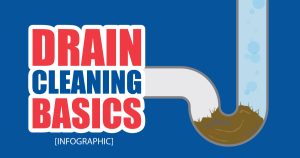Ask Art: Why Is My Kitchen Sink Clogged?

If you are currently sitting at home with a clogged kitchen sink, then you’ve come to the right place! A clogged kitchen sink is one of the most common issues to find in the home. For homeowners, it can become a massive and unpleasant problem if not dealt with correctly. Luckily for you, Art Rooter, Sewer & Drain Cleaning knows exactly what to do!
Here we’ll discuss how to identify the cause of the clog, how to remove it, and how to prevent it.
What Is Clogging My Kitchen Sink?
The first step to cleaning a clogged sink is to identify the cause. Take note of the common signs of a clogged drain – the earlier these signs are identified, the sooner you can treat the problem before it gets worse.
The most common sign is slow drainage. If you start to notice this, don’t wait for it to get worse. It will eventually become completely blocked and then there will be no drainage at all. Regardless of how ‘bad’ the blockage is, it’s important to remove the clog immediately.
There are a lot of things that can clog a kitchen sink, but the most common objects are the following:
Food Particles
The most common cause of a kitchen sink blockage is food.
Food particles tend to build up over time as they travel down the drain pipes. These food particles, although small, slowly collect inside the p-trap. The most common foods that cause clogging are fatty and greasy foods, cereals, soft bread particles, and coffee grounds.
Other common foods that cause clogs include rice, eggshells, pasta, bones, peels, and pits from fruits and vegetables.
Soapsuds
Soapsuds (foam and froth from dishwashing soaps) are not a well-known cause, but it is something worth noting.
Soap can soak into other food particles in the drain (for example bread or pasta), and make these particles swell. This increases the chances of a clog because it allows the food particles to build up in the p-trap.
Soap is also corrosive, and over time it can cause your pipes to erode, causing other sorts of plumbing problems too.
Liquid Grease, Fats, and Oils
Fats, grease, and oils that come from foods can coagulate inside the drain, acting as a glue to other food particles and making them stick in clumps.
The problem with fats and oils is that they seem fine in their liquid state, but then when it cools, it solidifies. Think of frying bacon in a pan, and how the fat drips off in a liquid form. Once the pan has cooled, the leftover fatty residue from the bacon becomes solid. This is what happens in the drain. If you were to drain the fat from the pan, as it drips down the drain, it would solidify inside the drain once it cools.
Even if you were to use a garbage disposal, the fat can cling to the blades and cause a clog as well. Fats and grease are the most difficult particles to remove due to their sticky nature.
Things That You Should Not Throw Down Your Kitchen Sink
In general, you should not be throwing any foods or solid objects down the drain. But the most important food particles to avoid are the following:
- Coffee grinds
- Eggshells
- Bones
- Banana peels
- Bread, pasta, and cereals
- Cores and pits of vegetables and fruits
Other non-food items that often end up in the kitchen sink are also a no-go zone:
- Solvents, paints, turpentine, nail polish remover and medications (pills)
- General cleaning liquids that contain corrosive chemicals
- Tissue paper
- Garbage
- Any liquid or solid fats, grease, and oils (whether food or not food-based)
- Hair (although this is a problem that you’re likely to find in the bathroom sink)
You might be thinking, but I have a garbage disposal! Isn’t that the purpose of a garbage disposal? Yes, technically it is, but it does not mean you should be throwing all your food or garbage bits down the drain.
A garbage disposal is meant to help clear any unwanted particles that may have fallen down the sink. It is there as a backup, and not as your main means of disposal, which should be the trash can. You should not be intentionally throwing food down the drain, especially grease or fats, as the garbage disposal cannot properly dispose of these things.
Unclogging Your Sink
Now that you have an idea of what could be causing a clog, the first step is to look down the drain for the culprit.
If you have a garbage disposal, first turn it off, and look inside for any clogs. Garbage disposals can easily get blocked with bits of food. If you do not have a garbage disposal, you can use a flashlight to look down the drain to try and determine the nature of the blockage. From there you can determine what to do next.
If the blockage is made of food particles and no solid objects, you could try a natural, environmentally friendly drain cleaner to clear the clog. Normal drain cleaners are not advisable, as they contain harmful chemicals. These dangerous chemicals should not be in the home if you have children or pets. What’s more, the harmful chemicals can erode and deteriorate your pipes from the inside-out over time.
If you do not have a natural drain cleaner try using a plunger instead.
It is important to note that using a drain cleaner or a plunger would be a short-term fix. Plungers and drain cleaners can only remove the clog at a surface level, so the clogging can build up quickly again. Therefore, we recommend you skip the hassle, and use a plumbing service from a licensed plumber. There are several reasons why you should use a licensed plumber.
If you’re having drain issues call Art Rooter, Sewer & Drain Cleaning at 1-888-773-1524, today!








